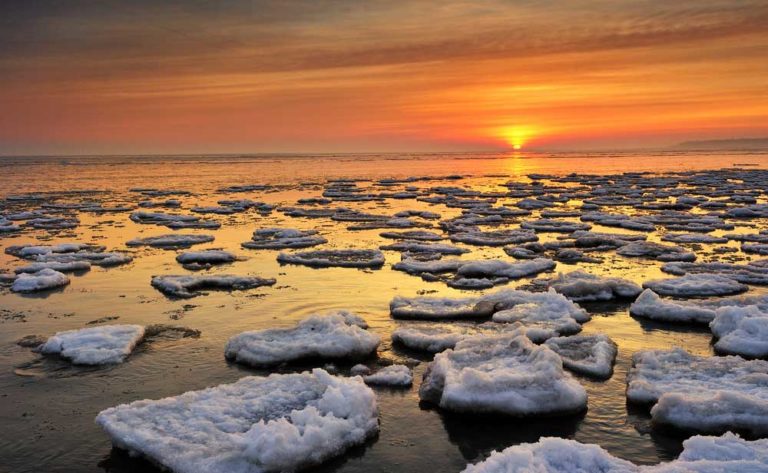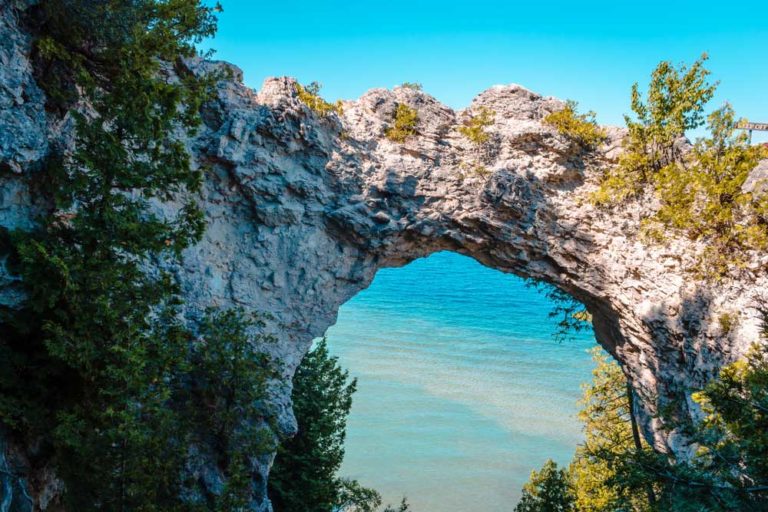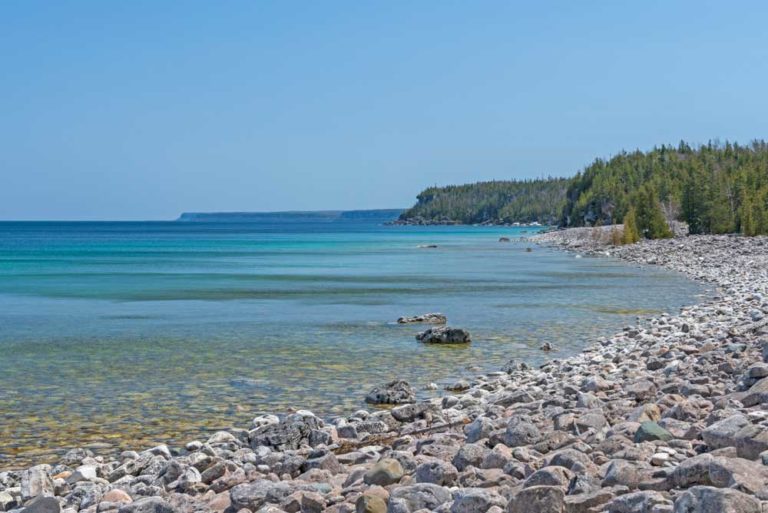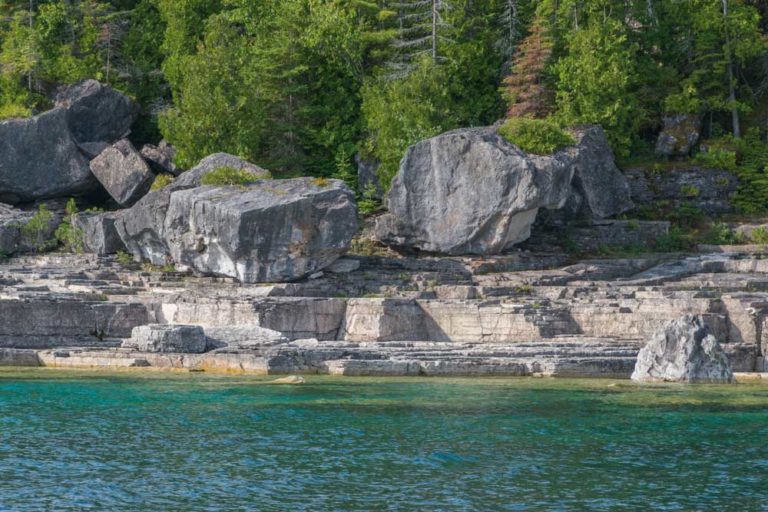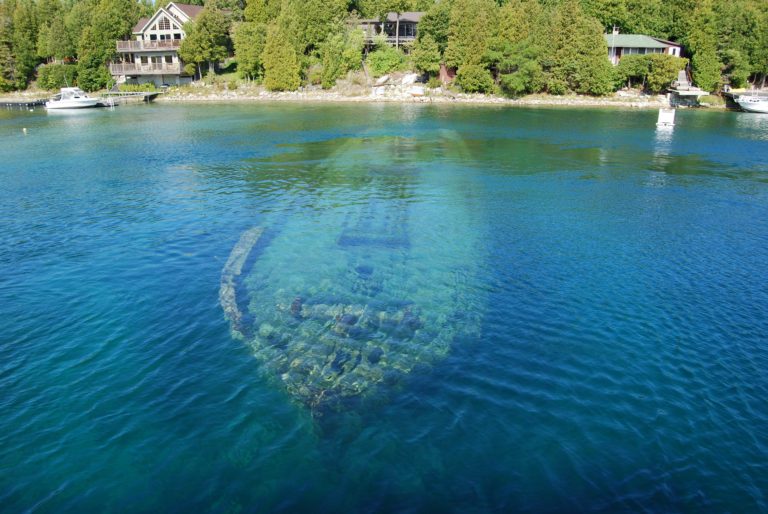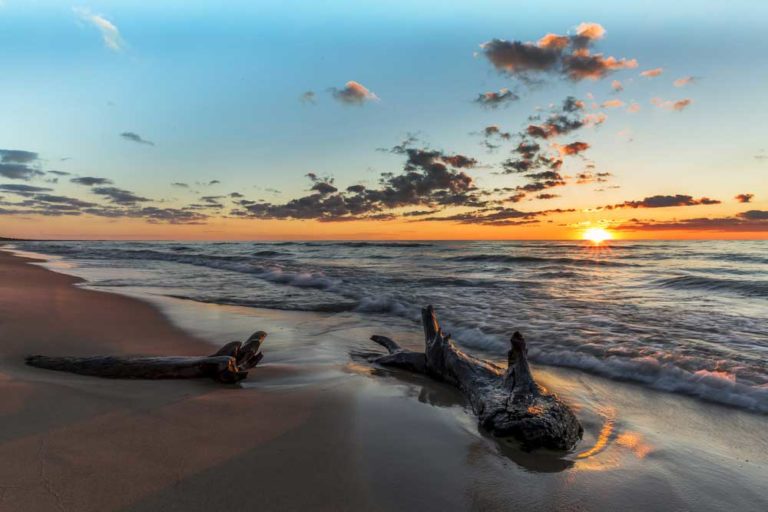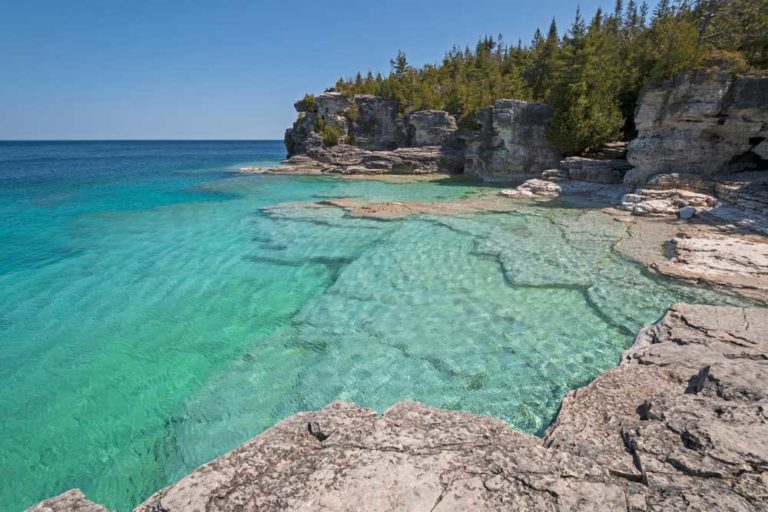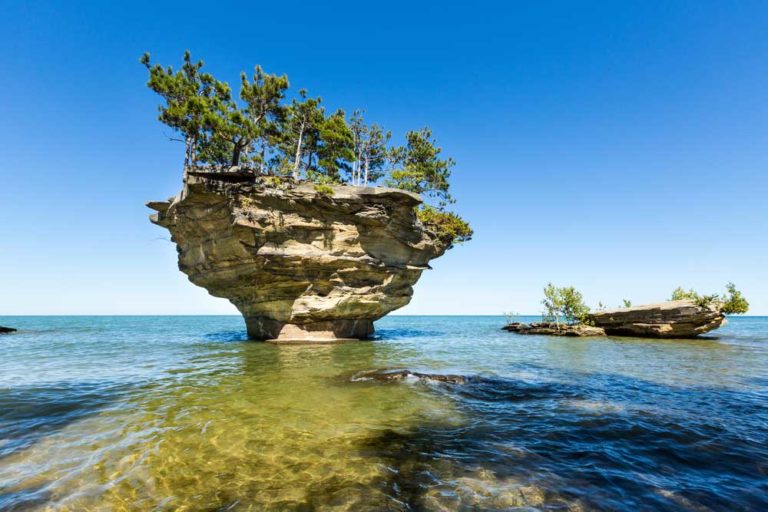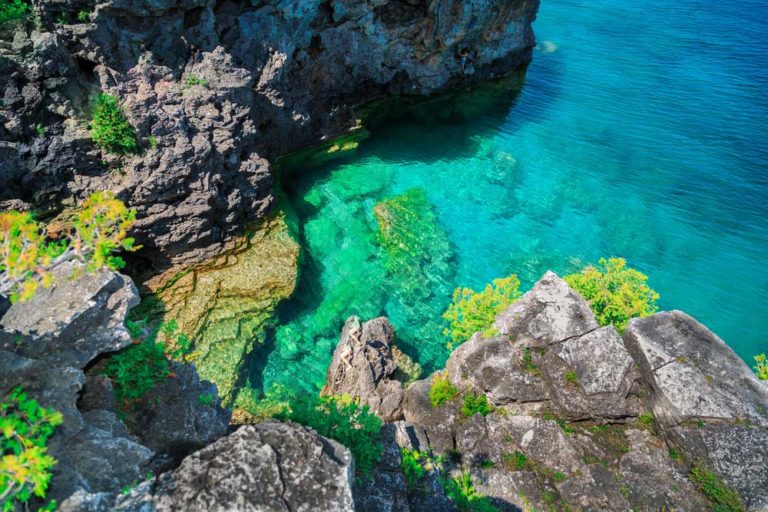Lake Huron
Keen fishermen may find:
- Perch
- Bass
- Lake Trout
- Rainbow Trout
- Whitefish
- Salmon
- Northern Pike
Lake, Huron, the second-largest Great Lake, defines Manitoulin Island. After all, if you’re the largest Island in the world in fresh water, you need that fresh water. But, where would you start to write about such a big body of water? Lake Huron is so darn big, 23,000 square miles, with depths up to 750 feet, and its history so rich and varied, it wasn’t like I could really do it justice in a couple of pages.
I decided to focus on the lake as experienced from the south shore of the Island, which is, after all, what people really think about when you say, “Lake Huron.” The North Channel is part of the lake, sure, but it’s a distinct part, a world unto itself; so is Georgian Bay. That limitless sprawl of blue that you see from the south shore, corrugated with big waves and faintly specked with fishing boats, now that’s the true Lake Huron.
So, I packed my wide-angle lens, and set off for Providence Bay. (Actually, I don’t have a wide-angle lens, but you get my point.) Enroute, I thought about Lake Huron, its history, its mystique, its stats. Where to start?
Well, it’s the second largest Great Lake, we all know that, right? It’s also, in my view the greatest of all the Great Lakes.
Sure, Superior is greatest in size, with the most dramatic, precipitous coastline, but it’s a daunting, scary lake, difficult to safely experience unless you’re in a big boat, and even then, you might not be safe. Consider the fairly recent fate of the Edmund Fitzgerald, a shipwreck we all know about thanks to singer songwriter Gordon Lighfoot.
Lake Huron, with its infinite islands and varied shorelines, ranging from long sand beaches in the south, to crazy granite and quartzite in the north, to the limestone flowerpots and bluffs and alvars of Tobermory and Manitoulin, has always struck me as way more enticing and unique than Michigan, Ontario or Erie, but also more hospitable and navigable than its more voluminous sibling to the north.
Huron has no big cities on its shore, unless you count Sarnia. It has dozens of lighthouses, and tens of thousands of islands, including, of course, the world’s largest to be found in fresh water.
The first European to set eyes on Lake Huron was presumably Samuel de Champlain, after navigating the French River to its mouth in 1615 (it’s possible that Etienne Brule got there earlier, but no precise record exists of his travels). Here, Champlain encountered a group of natives who were gathering blueberries; natives, as it happened, from Manitoulin Island.
A few decades later, in 1649, the Huron Nation (from which the lake derives its name,) and the fort established by the French at St. Marie among the Hurons, were routed by the Iroquois in the present-day Midland area in southern Georgian Bay.
Mantioulin’s first Jesuit mission, begun in 1648, was promptly abandoned after these Iroquois raids, and the Island’s Ojibwe and Odawa population scattered far and wide. It wasn’t until the early 1800s that Manitoulin natives returned, and a new mission was established in present-day Wiikwemkoong Unceded Territory.
One of the Island’s more mysterious and sensational events occurred in Lake Huron waters off Wiikwemkoong in 1863. A corrupt fisheries commissioner named William Gibbarb, much loathed by the local first nations people, disappeared while returning to Manitoulin on board a steamer named the Ploughboy; his body was found floating in the lake three days later. No one was ever charged, but people in Wiky have an idea about what might have happened to this day. The story lingers on as “ The Manitoulin Incident” and 20 years ago Wiikwemkoong playwright Alanis King created a play from the story that was presented by the Debajehmujig Theatre Group.
The greatest loss of life on the Great Lakes for its time also occurred in Lake Huron, not far from Manitoulin. In 1882, the poorly designed and overloaded steamer Asia foundered en route to Manitowaning in a storm, killing all but two of its 144 passengers. One of the survivors was Dunk Tinkis of Little Current; the other was a young woman named Christine Morrison. The two teenagers, strangers to one another, but both, uncannily enough, 17, drifted to an island near Pointe Au Baril on a lifeboat, and were discovered the next day by a native couple. There is a monument to the event at Dunk Tinkis’ burial place in the Holy Trinity Cemetery just outside of Little Current.
As I pulled into Providence Bay, parked, and got out to wander around on the beach, it was hard to imagine the sort of storm that might sink a boat the size of the Asia (136 feet). There was a brisk wind blowing this day, but it was out of the north, so the bay was quite calm, and the sun was bright and warm.
The beach at “Prov,” as the community is locally and affectionately known, is certainly one of the Island’s most popular spots, and deservedly so. But having never been the sort of person who likes to laze around on a crescent of sand, possibly exposing himself to skin cancer, I kept my tour short, and then headed for one of my favourite places on all of Manitoulin, the rocky east shore of the bay.
I parked at the marina, and started hiking down this rugged, scenic coast, striding over deep cracks in the fossil-strewn limestone slabs, tiptoeing across wave-smoothed stones, occasionally leaving the tread-marks of my boots in small pockets of sand.
Eventually I reached the light of Providence Point. It’s an unmanned light on a tripod tower. Just in front of it, though, you can see the foundation of the original lighthouse which once stood here.
According to the book Alone at Night, the “Prov” lighthouse was built in 1904 and was manned until 1953. In 1973, it mysteriously burnt to the ground. Some believed it was struck by lightning, but nobody seems to want to name names. The general theory, though, is that it was a local person who had some sort of gripe with the government.
After standing on the foundation of this lighthouse, gone now almost 50 years, I started hiking back to the marina.
The marina was hopping: boats pulling out, boats pulling in. I spoke briefly with a father-daughter team fishing, from Sudbury, who were trailering their boat into the water, setting out to do some salmon fishing. They’d been skunked the last time they went out fishing from Prov but told me they’d had success in the past. I wished them luck, and watched as they struck out onto the bay, rods jutting from stern of the boat. Perhaps they’ll be entering The Manitoulin Expositor Salmon Classic (last Saturday in July through the last Sunday in August) and trying to win some of the $30,000 cash prize money for a championship salmon.
A big, weather-beaten boat was tethered to the end of the pier, out past the slips. I had a hunch what it was but had never seen it up close. I wandered out to get a better look, and sure enough, it was the Blue Fin, the venerable fishing tug operated by the Purvis family in Burnt Island.
Incredibly, this riveted steel boat has been in been in service since 1930, the year that the grandfather of current Purvis patriarch George Purvis had it built.
Out past the end of the pier, you can see another old section of dock, stuck out there like a sad, skeletal island. The pier obviously extended much farther at one time.
I talked to the harbourmaster about this. He showed me a photocopy of an old newspaper article, from the Sudbury Daily Star; dated May 6, 1952. “Providence Bay hit by tidal wave,” was the headline. Although the article didn’t go into details of damage done to the dock, the harbourmaster said it was his understanding that “that was when the pier got broken up. It used to be all one piece.”
Remember what I said about Lake Huron being so much more hospitable than Lake Superior? Maybe I should be taking that back. After all, Providence Bay itself was reputedly named after a ship-wreck. The story goes that some shipwrecked sailors washed up on its sandy shore, and thanked providence for their good fortune. Other stories tell of the “sailors’ grave,” a small grotto-like area amid tall rocks, now encircled by Providence Bay Park.
I’d seen this natural sculpture before and told myself I should really go and pay my respects before heading home.

